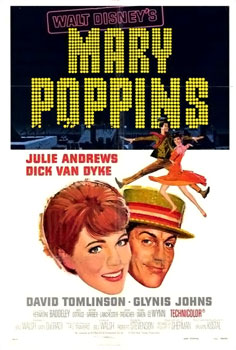
Mary Poppins (film)
Mary Poppins is a 1964 American musical fantasy comedy film directed by Robert Stevenson and produced by Walt Disney, with songs written and composed by the Sherman Brothers. The screenplay is by Bill Walsh and Don DaGradi, based on P. L. Travers's book series Mary Poppins. The film, which combines live-action and animation, stars Julie Andrews in her feature film debut as Mary Poppins, who visits a dysfunctional family in London and employs her unique brand of lifestyle to improve the family's dynamic. Dick Van Dyke, David Tomlinson, and Glynis Johns are featured in supporting roles. The film was shot entirely at the Walt Disney Studios in Burbank, California, using painted London background scenes.[7]
Mary Poppins was released on August 27, 1964, to critical acclaim and commercial success, earning $44 million in theatrical rentals in its original run. It became the highest-grossing film of 1964 in the United States, and at the time of its release became Disney's highest-grossing film. During its theatrical lifetime, it grossed over $103 million worldwide. It received a total of thirteen Academy Award nominations—a record for any film released by Walt Disney Studios—including Best Picture, and won five: Best Actress for Andrews, Best Film Editing, Best Original Music Score, Best Visual Effects, and Best Original Song for "Chim Chim Cher-ee". It is considered Walt Disney's crowning live-action achievement, and is the only one of his films to earn a Best Picture nomination during his lifetime.[7] In 2013, it was selected for preservation in the United States National Film Registry by the Library of Congress as being "culturally, historically, or aesthetically significant".[8]
A biographical drama based on the making of the film, Saving Mr. Banks, was released on October 20, 2013. A sequel, Mary Poppins Returns, was released on December 19, 2018.[9][10]
Reception[edit]
Box office[edit]
Mary Poppins earned $31 million in theatrical rentals in the United States and Canada during its initial run.[46] It was one of the top 12 grossing films in the United States for 32 weeks.[47] It earned rentals of $44 million worldwide in its initial release.[48]
The film was re-released theatrically in 1973, in honor of Walt Disney Productions' 50th anniversary, and earned an estimated additional $9 million in rentals in the United States and Canada.[49] It was released once more in 1980 and grossed $14 million.[20] It returned a total lifetime rental of $45 million in the United States and Canada[50] to Disney from a gross of over $102 million.[6]
It was the 20th most popular sound film of the 20th century in the United Kingdom with admissions of 14 million.[51]
The film was very profitable for Disney. Made on an estimated budget of $4.4–6 million,[5][52][53] it was reported by Cobbett Steinberg to be the most profitable film of 1965, earning a net profit of $28.5 million.[54][a] Walt Disney used his huge profits from the film to purchase land in central Florida and finance the construction of Walt Disney World.[56]
Critical reception[edit]
The film received universal acclaim from critics.[54] Whitney Williams of Variety praised its musical sequences and Andrews' and Van Dyke's performances in particular.[57] Time lauded the film, stating, "The sets are luxuriant, the songs lilting, the scenario witty but impeccably sentimental, and the supporting cast only a pinfeather short of perfection."[58] Bosley Crowther, reviewing for The New York Times, described the film as a "most wonderful, cheering movie … for the visual and aural felicities they have added to this sparkling color film—the enchantments of a beautiful production, some deliciously animated sequences, some exciting and nimble dancing and a spinning musical score—make it the nicest entertainment that has opened at the Music Hall this year."[59]
For The Hollywood Reporter, James Powers applauded the performances, visual effects, musical score, production design, and choreography, and commented: "Mary Poppins is a picture that is, more than most, a triumph of many individual contributions. And its special triumph is that it seems to be the work of a single, cohesive intelligence."[60] Ann Guerin of Life criticized the creative departures from the novels, particularly the "Jolly Holiday" sequence. She noted that "[s]ome of the sequences have real charm, and perhaps the kids will eat them up. But speaking as a grownup, I found a little bit went a long way." She concluded, "With a little more restraint and a little less improvement on the original, the film's many charms would have been that much better."[61]
On the review aggregator website Rotten Tomatoes, the films holds an approval rating of 96% based on 55 reviews, with an average rating of 8.4/10. The website's critics consensus reads, "A lavish modern fairy tale celebrated for its amazing special effects, catchy songs, and Julie Andrews's legendary performance in the title role."[62] Metacritic, which uses a weighted average, assigned the film a score of 88 out of 100, based on 13 critics, indicating "universal acclaim".[63] Critic Drew Casper summarized the impact of Mary Poppins in 2011: